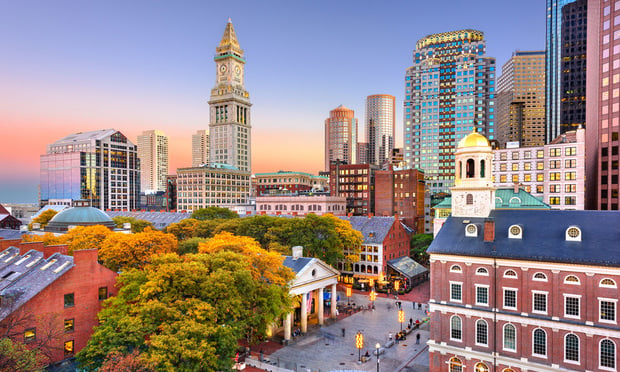BOSTON—While the talk of the real estate industry in Greater Boston continues to be its electric office market, those engaged in the industrial sector have something positive to crow about as well—strong demand and a record low vacancy rate.
In Transwestern | RBJ's latest quarterly report on the Greater Boston industrial market, although there was no high profile deal like General Electric in the first quarter, strong demand, particularly from e-commerce related companies, sparked the seventh consecutive quarter of positive absorption (387,000 square feet) in the region.
The overall industrial vacancy rate for Greater Boston fell to 10.3%, a new record. The overall rate at year-end 2015 was 10.8%. The warehouse market's vacancy rate also fell to a new record low of 10.1% in the first quarter of this year thanks to 508,000 square feet of positive absorption The manufacturing sector saw its vacancy rate rise to 11% due to a negative 121,000 square feet of absorption in the first quarter. Transwestern Northeast research director Chase Bourdelaise attributes the downtown in the manufacturing sector to overseas instability and a strong dollar. However, he foresees better things later this year for this sector, noting that the manufacturing sector's vacancy rate has fallen six percentage points in the last four years. The flex sector enjoyed 292,000 square feet of positive absorption, which led to its vacancy rate falling 1.1 percentage points from year-end 2015 to 12.8%.
Overall industrial asking rents rose nearly 5% to $6.70-a-square-foot. Asking rents for flex space hit the highest level since 2005 at $10.10-a-square-foot. Asking rents in the warehouse sector rose above $6-a-square-foot for the first time since 2008, reaching $6.04-a-square-foot in the first quarter of 2016. Manufacturing asking rents rose to $8.28-a-square-foot, which Transwestern notes is $1.51-a-square-foot higher than the five-year average.
“The overall results for the quarter were strong, with warehouse and flex property types performing particularly well,” Bourdelaise says. “After setting a new record low for vacancy in fourth-quarter 2015, the warehouse market tightened even further this quarter. We anticipate continued positive results throughout 2016.”
According to the report, during the current 15-quarter streak of positive absorption for the warehouse sector, a total of 6 million square feet of warehouse space has been taken off the market.
Bourdelaise says that the burgeoning e-commerce industry is driving growth in the industrial sector in Boston. He tells Globest.com that the e-commerce's projected increase in retail market share in years to come will only spark more demand for space in and around Boston and could prompt some developers to build new specialized fulfillment center-oriented projects to meet demand.
In the first quarter of 2016, there were no new industrial properties added to the market and the brokerage firm reports that there are only two new industrial projects under construction in the Greater Boston area at the moment. Tightening market conditions are also being exacerbated by some recent conversions of industrial properties in and around Boston to residential use, Bourdelaise notes. He expects vacancy rates in the industrial market to continue to tighten this year.
Some other notable takeaways from the report include:
• The Route 128 warehouse market has posted positive absorption in 15 of the last 16 quarters, totaling 2.3 million square feet. The manufacturing vacancy rate in the Route 128 South area is now at 3.3%, a 10.2-percentage point decline from the fourth quarter of 2013. The vacancy rate for flex space in the Route 128 South area fell to single-digits for the first time in more than 15 years. The first quarter's 8.9% vacancy rate was 10.8 percentage points lower than this time a year ago.
• The warehouse vacancy rate in the Metro South District has reached a record-low of 12.6%.
• The state's focus on retaining and growing manufacturing was bolstered by the news that Massachusetts has been chosen to lead the new $317-million Revolutionary Fibers and Textiles Manufacturing Innovation Institute, which will be led by MIT.
• Industrial deals of note in the first quarter included Cold Chain Technologies move into 227,000 square feet of warehouse space at 135 Constitution Blvd, in Franklin, HD Supply's renewal of 152,000 square feet at the 100 Meadow Road industrial warehouse building in Boston, and Scheidt & Buchanan's (72,000 square feet) and OYO's (64,000 square feet) respective flex deals at 101 Pawtucket Blvd, in Lowell and 111 Locke Drive in Marlborough.
BOSTON—While the talk of the real estate industry in Greater Boston continues to be its electric office market, those engaged in the industrial sector have something positive to crow about as well—strong demand and a record low vacancy rate.
In Transwestern | RBJ's latest quarterly report on the Greater Boston industrial market, although there was no high profile deal like
The overall industrial vacancy rate for Greater Boston fell to 10.3%, a new record. The overall rate at year-end 2015 was 10.8%. The warehouse market's vacancy rate also fell to a new record low of 10.1% in the first quarter of this year thanks to 508,000 square feet of positive absorption The manufacturing sector saw its vacancy rate rise to 11% due to a negative 121,000 square feet of absorption in the first quarter. Transwestern Northeast research director Chase Bourdelaise attributes the downtown in the manufacturing sector to overseas instability and a strong dollar. However, he foresees better things later this year for this sector, noting that the manufacturing sector's vacancy rate has fallen six percentage points in the last four years. The flex sector enjoyed 292,000 square feet of positive absorption, which led to its vacancy rate falling 1.1 percentage points from year-end 2015 to 12.8%.
Overall industrial asking rents rose nearly 5% to $6.70-a-square-foot. Asking rents for flex space hit the highest level since 2005 at $10.10-a-square-foot. Asking rents in the warehouse sector rose above $6-a-square-foot for the first time since 2008, reaching $6.04-a-square-foot in the first quarter of 2016. Manufacturing asking rents rose to $8.28-a-square-foot, which Transwestern notes is $1.51-a-square-foot higher than the five-year average.
“The overall results for the quarter were strong, with warehouse and flex property types performing particularly well,” Bourdelaise says. “After setting a new record low for vacancy in fourth-quarter 2015, the warehouse market tightened even further this quarter. We anticipate continued positive results throughout 2016.”
According to the report, during the current 15-quarter streak of positive absorption for the warehouse sector, a total of 6 million square feet of warehouse space has been taken off the market.
Bourdelaise says that the burgeoning e-commerce industry is driving growth in the industrial sector in Boston. He tells Globest.com that the e-commerce's projected increase in retail market share in years to come will only spark more demand for space in and around Boston and could prompt some developers to build new specialized fulfillment center-oriented projects to meet demand.
In the first quarter of 2016, there were no new industrial properties added to the market and the brokerage firm reports that there are only two new industrial projects under construction in the Greater Boston area at the moment. Tightening market conditions are also being exacerbated by some recent conversions of industrial properties in and around Boston to residential use, Bourdelaise notes. He expects vacancy rates in the industrial market to continue to tighten this year.
Some other notable takeaways from the report include:
• The Route 128 warehouse market has posted positive absorption in 15 of the last 16 quarters, totaling 2.3 million square feet. The manufacturing vacancy rate in the Route 128 South area is now at 3.3%, a 10.2-percentage point decline from the fourth quarter of 2013. The vacancy rate for flex space in the Route 128 South area fell to single-digits for the first time in more than 15 years. The first quarter's 8.9% vacancy rate was 10.8 percentage points lower than this time a year ago.
• The warehouse vacancy rate in the Metro South District has reached a record-low of 12.6%.
• The state's focus on retaining and growing manufacturing was bolstered by the news that
• Industrial deals of note in the first quarter included Cold Chain Technologies move into 227,000 square feet of warehouse space at 135 Constitution Blvd, in Franklin,
Want to continue reading?
Become a Free ALM Digital Reader.
Once you are an ALM Digital Member, you’ll receive:
- Breaking commercial real estate news and analysis, on-site and via our newsletters and custom alerts
- Educational webcasts, white papers, and ebooks from industry thought leaders
- Critical coverage of the property casualty insurance and financial advisory markets on our other ALM sites, PropertyCasualty360 and ThinkAdvisor
Already have an account? Sign In Now
*May exclude premium content© 2024 ALM Global, LLC, All Rights Reserved. Request academic re-use from www.copyright.com. All other uses, submit a request to [email protected]. For more information visit Asset & Logo Licensing.









